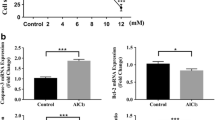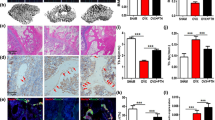Abstract
Estradiol could protect osteoblast against apoptosis, and apoptosis and autophagy were extensively and intimately connected. The aim of the present study was to test the hypothesis that autophagy was present in osteoblasts under serum deprivation and estrogen protected against osteoblast apoptosis via promotion of autophagy. MC3T3-E1 osteoblastic cells were cultured in a serum-free and phenol red-free minimal essential medium (α-MEM). Ultrastructural analysis, lysosomal activity assessment and monodansycadaverine (MDC) staining were employed to determine the presence of autophagy, and real time PCR was used to evaluate the expression of autophagic markers. Meanwhile, the osteoblasts were transferred in a serum-free and phenol red-free α-MEM containing either vehicle or estradiol. Apoptosis and autophagy was assessed by using the techniques of real-time PCR, Western blot, immunofluorescence assay, and flow cytometry. The possible pathway through which estrogen promoted autophagy in the serum-deprived osteoblasts was also investigated. Real-time PCR demonstrated the expression of LC3, beclin1 and ULK1 genes in osteoblasts under serum deprivation, and immunofluorescence assay verified high expression of proteins of these three autophagic bio-markers. Lysosomes and autolysosomes accumulated in the cytoplasm of osteoblasts were also detected under transmission electron microscopy, MDC staining and lysosomal activity assessment. Meanwhile, estradiol significantly decreased the expression of proteins of the bio-markers of apoptosis, and at the same time increased the expression of proteins of the bio-markers of autophagy in the serum-deprived osteoblasts. Furthermore, the estradiol-promoted autophagy in serum-deprived osteoblasts could be blocked by estrogen receptor (ER) antagonist (ICI 182780), and estradiol failed to rescue the cells pretreated with an inhibitor of vacuolar ATPase (bafilomycin A) from apoptosis. Serum deprivation resulted in apoptosis through activation of Caspase-3 and induced autophagy through inhibition of phospho-mammalian target of rapamycin (p-mTOR). Both 3-methyladenine (3MA) and U0126 led to increase of apoptosis in osteoblasts with serum deprivation. Estradiol failed to over-ride the inhibitory effect of 3MA on phosphorylation of AKT but directly led to dephosphorylation of mTOR and upregulation of LC3 protein expression. However, the estradiol-enhanced LC3 protein expression was significantly suppressed by U0126 through inhibition of phosphorylation of extracellular signal-regulated kinase (ERK). Estradiol rescued osteoblast apoptosis via promotion of autophagy through the ER–ERK–mTOR pathway.






Similar content being viewed by others
References
Khosla S, Oursler MJ, Monroe DG (2012) Estrogen and the skeleton. Trends Endocrinol Metab 23:576–581
Riggs BL, Khosla S, Melton LJ 3rd (1998) A unitary model for involutional osteoporosis: estrogen deficiency causes both type I and type II osteoporosis in postmenopausal women and contributes to bone loss in aging men. J Bone Miner Res 13:763–773
Harada S, Rodan GA (2003) Control of osteoblast function and regulation of bone mass. Nature 423:349–355
Gohel A, McCarthy MB, Gronowicz G (1999) Estrogen prevents glucocorticoid-induced apoptosis in osteoblasts in vivo and in vitro. Endocrinology 140:5339–5347
Manolagas SC, Kousteni S, Jilka RL (2002) Sex steroids and bone. Recent Prog Horm Res 57:385–409
Yang Z, Klionsky DJ (2010) Eaten alive: a history of macroautophagy. Nat Cell Biol 12:814–822
Thorburn A (2008) Apoptosis and autophagy: regulatory connections between two supposedly different processes. Apoptosis 13:1–9
Djavaheri-Mergny M, Maiuri MC, Kroemer G (2010) Cross talk between apoptosis and autophagy by caspase-mediated cleavage of Beclin 1. Oncogene 29:1717–1719
Thorburn J, Moore F, Rao A et al (2005) Selective inactivation of a Fas-associated death domain protein (FADD)-dependent apoptosis and autophagy pathway in immortal epithelial cells. Mol Biol Cell 16:1189–1199
Ganatra DA, Johar KS, Parmar TJ et al (2013) Estrogen mediated protection of cytoskeleton against oxidative stress. Indian J Med Res 137:117–124
Shafin N, Zakaria R, Hussain NH et al (2012) Association of oxidative stress and memory performance in postmenopausal women receiving estrogen-progestin therapy. Menopause
Chen X, Deng Y, Zhou Z et al (2010) 17beta-estradiol combined with testosterone promotes chicken osteoblast proliferation and differentiation by accelerating the cell cycle and inhibiting apoptosis in vitro. Vet Res Commun 34:143–152
Topcuoglu A, Uzun H, Balci H et al (2009) Effects of estrogens on oxidative protein damage in plasma and tissues in ovariectomised rats. Clin Investig Med 32:E133–E143
Khan RS, Fonseca-Kelly Z, Callinan C et al (2012) SIRT1 activating compounds reduce oxidative stress and prevent cell death in neuronal cells. Front Cell Neurosci 6:63
Charles I, Khalyfa A, Kumar DM et al (2005) Serum deprivation induces apoptotic cell death of transformed rat retinal ganglion cells via mitochondrial signaling pathways. Invest Ophthalmol Vis Sci 46:1330–1338
Liu SY, Chen CL, Yang TT et al (2012) Albumin prevents reactive oxygen species-induced mitochondrial damage, autophagy, and apoptosis during serum starvation. Apoptosis 17:1156–1169
Behl C, Widmann M, Trapp T et al (1995) 17-beta estradiol protects neurons from oxidative stress-induced cell death in vitro. Biochem Biophys Res Commun 216:473–482
Bursch W, Hochegger K, Torok L et al (2000) Autophagic and apoptotic types of programmed cell death exhibit different fates of cytoskeletal filaments. J Cell Sci 113(Pt 7):1189–1198
Shen C, Yan J, Jiang LS et al (2011) Autophagy in rat annulus fibrosus cells: evidence and possible implications. Arthritis Res Ther 13:R132
Taylor RC, Cullen SP, Martin SJ (2008) Apoptosis: controlled demolition at the cellular level. Nat Rev Mol Cell Biol 9:231–241
Korsmeyer SJ (1995) Regulators of cell death. Trends Genet 11:101–105
Wander SA, Hennessy BT, Slingerland JM (2011) Next-generation mTOR inhibitors in clinical oncology: how pathway complexity informs therapeutic strategy. J Clin Invest 121:1231–1241
Fiorini C, Menegazzi M, Padroni C et al (2013) Autophagy induced by p53-reactivating molecules protects pancreatic cancer cells from apoptosis. Apoptosis 18:337–346
Ding Y, Kim JK, Kim SI et al (2010) TGF-β1 protects against mesangial cell apoptosis via induction of autophagy. J Biol Chem 285:37909–37919
Lin JF, Tsai TF, Liao PC et al (2013) Benzyl isothiocyanate induces protective autophagy in human prostate cancer cells via inhibition of mTOR signaling. Carcinogenesis 34:406–414
McGonnell IM, Grigoriadis AE, Lam EW et al (2012) A specific role for phosphoinositide 3-kinase and AKT in osteoblasts? Front Endocrinol (Lausanne) 3:88
Prouillet C, Maziere JC, Maziere C et al (2004) Stimulatory effect of naturally occurring flavonols quercetin and kaempferol on alkaline phosphatase activity in MG-63 human osteoblasts through ERK and estrogen receptor pathway. Biochem Pharmacol 67:1307–1313
Chen JR, Plotkin LI, Aguirre JI et al (2005) Transient versus sustained phosphorylation and nuclear accumulation of ERKs underlie anti-versus pro-apoptotic effects of estrogens. J Biol Chem 280:4632–4638
Aguirre JI, Plotkin LI, Gortazar AR et al (2007) A novel ligand-independent function of the estrogen receptor is essential for osteocyte and osteoblast mechanotransduction. J Biol Chem 282:25501–25508
Degenhardt K, Mathew R, Beaudoin B et al (2006) Autophagy promotes tumor cell survival and restricts necrosis, inflammation, and tumorigenesis. Cancer Cell 10:51–64
Canu N, Tufi R, Serafino AL et al (2005) Role of the autophagic-lysosomal system on low potassium-induced apoptosis in cultured cerebellar granule cells. J Neurochem 92:1228–1242
Ohsawa Y, Isahara K, Kanamori S et al (1998) An ultrastructural and immunohistochemical study of PC12 cells during apoptosis induced by serum deprivation with special reference to autophagy and lysosomal cathepsins. Arch Histol Cytol 61:395–403
Lockshin RA, Zakeri Z (2004) Apoptosis, autophagy, and more. Int J Biochem Cell Biol 36:2405–2419
Xia X, Kar R, Gluhak-Heinrich J et al (2010) Glucocorticoid-induced autophagy in osteocytes. J Bone Miner Res 25:2479–2488
Ye YC, Yu L, Wang HJ et al (2011) TNFalpha-induced necroptosis and autophagy via supression of the p38-NF-kappaB survival pathway in L929 cells. J Pharmacol Sci 117:160–169
Farkas T, Daugaard M, Jaattela M (2011) Identification of small molecule inhibitors of phosphatidylinositol 3-kinase and autophagy. J Biol Chem 286:38904–38912
Lai EH, Hong CY, Kok SH et al (2012) Simvastatin alleviates the progression of periapical lesions by modulating autophagy and apoptosis in osteoblasts. J Endodontists 38:757–763
Khosla S, Melton LJ 3rd, Riggs BL (2011) The unitary model for estrogen deficiency and the pathogenesis of osteoporosis: is a revision needed? J Bone Miner Res 26:441–451
Chow J, Tobias JH, Colston KW et al (1992) Estrogen maintains trabecular bone volume in rats not only by suppression of bone resorption but also by stimulation of bone formation. J Clin Investig 89:74–78
Almeida M, Martin-Millan M, Ambrogini E et al (2010) Estrogens attenuate oxidative stress and the differentiation and apoptosis of osteoblasts by DNA-binding-independent actions of the ER alpha. J Bone Miner Res 25:769–781
Edwards MW, Bain SD, Bailey MC et al (1992) 17beta estradiol stimulation of endosteal bone formation in the ovariectomized mouse: an animal model for the evaluation of bone-targeted estrogens. Bone 13:29–34
Sobolewska A, Gajewska M, Zarzynska J et al (2009) IGF-I, EGF, and sex steroids regulate autophagy in bovine mammary epithelial cells via the mTOR pathway. Eur J Cell Biol 88:117–130
Kallio A, Guo T, Lamminen E et al (2008) Estrogen and the selective estrogen receptor modulator (SERM) protection against cell death in estrogen receptor alpha and beta expressing U2OS cells. Mol Cell Endocrinol 289:38–48
Hofbauer LC, Khosla S, Dunstan CR et al (1999) Estrogen stimulates gene expression and protein production of osteoprotegerin in human osteoblastic cells. Endocrinology 140:4367–4370
Viereck V, Grundker C, Friess SC et al (2005) Isopropanolic extract of black cohosh stimulates osteoprotegerin production by human osteoblasts. J Bone Miner Res 20:2036–2043
Wang QP, Yang L, Li XP et al (2012) Effects of 17beta-estradiol on adiponectin regulation of the expression of osteoprotegerin and receptor activator of nuclear factor-kappaB ligand. Bone 51:515–523
Klionsky DJ, Abdalla FC, Abeliovich H et al (2012) Guidelines for the use and interpretation of assays for monitoring autophagy. Autophagy 8:445–544
Singh BN, Kumar D, Shankar S et al (2012) Rottlerin induces autophagy which leads to apoptotic cell death through inhibition of PI3K/Akt/mTOR pathway in human pancreatic cancer stem cells. Biochem Pharmacol 84:1154–1163
Kim J, Kundu M, Viollet B et al (2011) AMPK and mTOR regulate autophagy through direct phosphorylation of Ulk1. Nat Cell Biol 13:132–141
Bennett HL, Fleming JT, O’Prey J et al (2010) Androgens modulate autophagy and cell death via regulation of the endoplasmic reticulum chaperone glucose-regulated protein 78/BiP in prostate cancer cells. Cell Death Dis 1:e72
Acknowledgments
This study was supported by the National Natural Science Foundation of China (81171757, U1032001) and funds from the Commission of Science Technology of Shanghai (11JC1408500).
Author information
Authors and Affiliations
Corresponding authors
Additional information
Yue-Hua Yang and Ke Chen contributed equally to this paper.
Rights and permissions
About this article
Cite this article
Yang, YH., Chen, K., Li, B. et al. Estradiol inhibits osteoblast apoptosis via promotion of autophagy through the ER–ERK–mTOR pathway. Apoptosis 18, 1363–1375 (2013). https://doi.org/10.1007/s10495-013-0867-x
Published:
Issue Date:
DOI: https://doi.org/10.1007/s10495-013-0867-x




